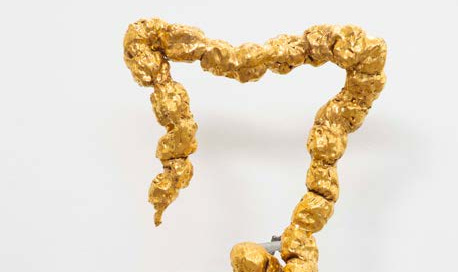Laura Pientka: Royal Flush
Chocolate colonic
We’re generally fans of Andreas Keller, a guy with a PhD in philosophy who is deep into olfaction. We’ve even published a paper with him. Since finishing a post-doc and research associate stint at Rockefeller University, he’s been running Olfactory Art Keller down on Manhattan’s Lower East Side, a gallery where he showcases an amazing number of olfactory artists.
His most recent featured artwork is, uh, somewhat less than appetizing.
Olfactory Art Keller is honored to bring the German ceramicist Laura Pientka’s Royal Flush to New York. Consisting of a ceramic colon, which is refined with gold luster and connected to a chocolate tempering device, Royal Flush continuously pumps liquid chocolate through the colon. The artist will be present for the experience and guide visitors in exploring her installation gustatorily by covering the fruits she will provide with the liquid chocolate emerging from the colon.
[Note to self: stop reading emails over lunch.]
Scientific spam goes wide of the mark
Dear Researcher,
Greetings!
With reference to your article “«Human olfactory detection of packaged cannabis»”, We would like to know your interest to participate as a speaker at our International Conference on Oceanography and Marine Biology to be held from September 09-10, 2024 in Barcelona Airport Hotel, Barcelona, Spain.
Theme : Current Research on Oceanography and Marine Biology
Hmmm. I could give a paper on the possibility of floating cannabis cultivation platforms moored in international waters . . .
Cheesy topnotes
This cringey faux parfum ad campaign is from Binance, “the leading blockchain ecosystem behind the world’s largest crypto exchange by trading volume.” The objective? “to bring more women into crypto and foster greater inclusivity in the space.”
Sounds like a moth-balled episode from HBO’s Silicon Valley: “We’re making the world a better place. For women. In crypto.”
The many faces of disgust
Finally, an interesting, offbeat paper by a group of researchers in Liverpool. They looked at congenital anosmics, i.e., people born without a sense of smell. Such people are potentially at risk from failing to detect odor-cued hazards, such as spoiled food. Might they, as a consequence, be more sensitive to other people’s facial expression of emotion? By noting someone else’s disgust reaction to reheated leftovers, for example, they could save themselves from a case of food poisoning.
The UK team tested facial recognition to expressions of anger, disgust, fear, happiness, and sadness. The only difference between congenital anosmics and people with a normal sense of smell was that anosmics detect facial expressions of disgust and anger at lower intensities. Score one for the vicarious experience of disgust hypothesis!
James Drummond, Adarsh Makdani, Ralph Pawling and Susannah C. Walker. Congenital anosmia and facial emotion recognition. 2024. Physiology & Behavior, published online March 14, 2024.







